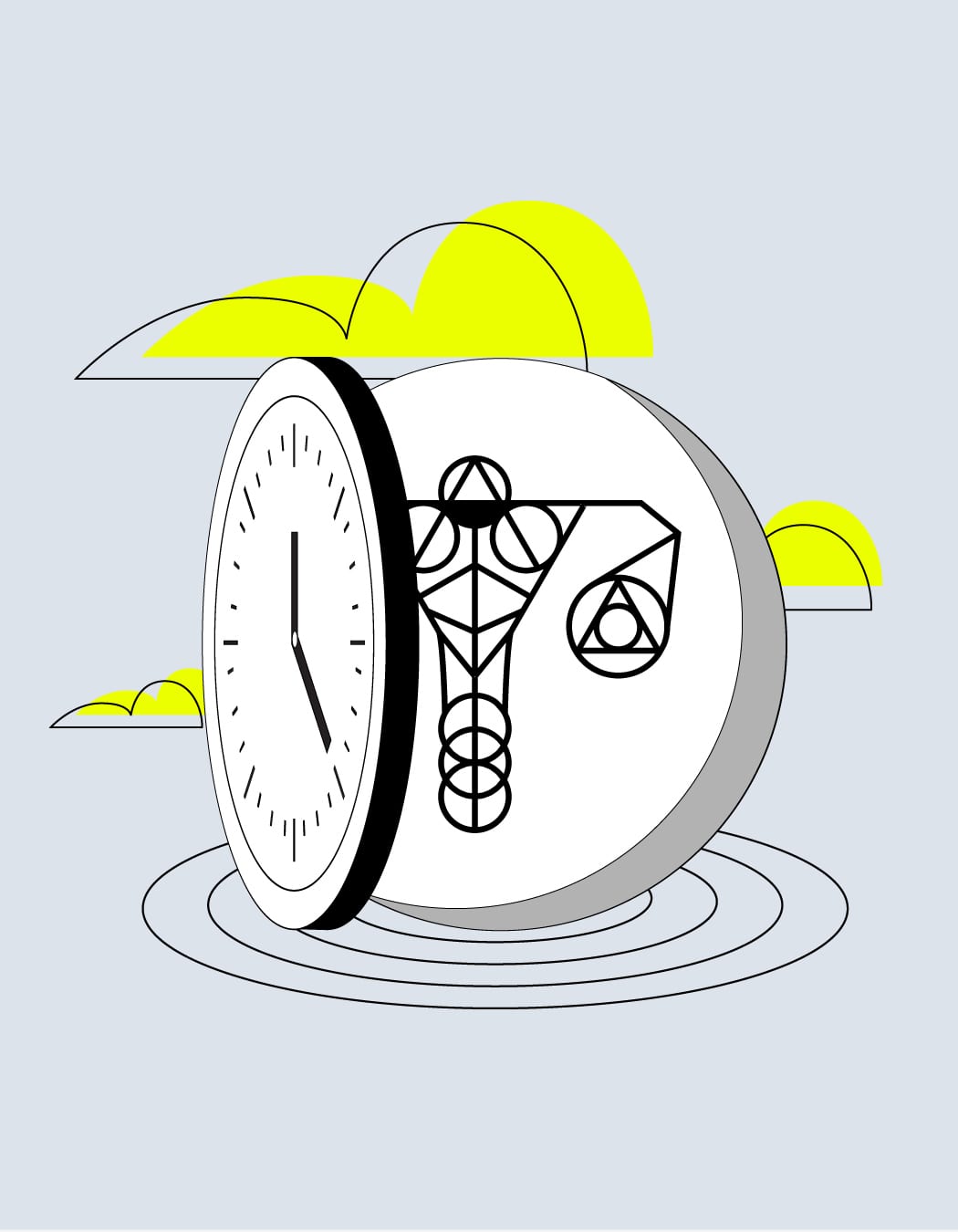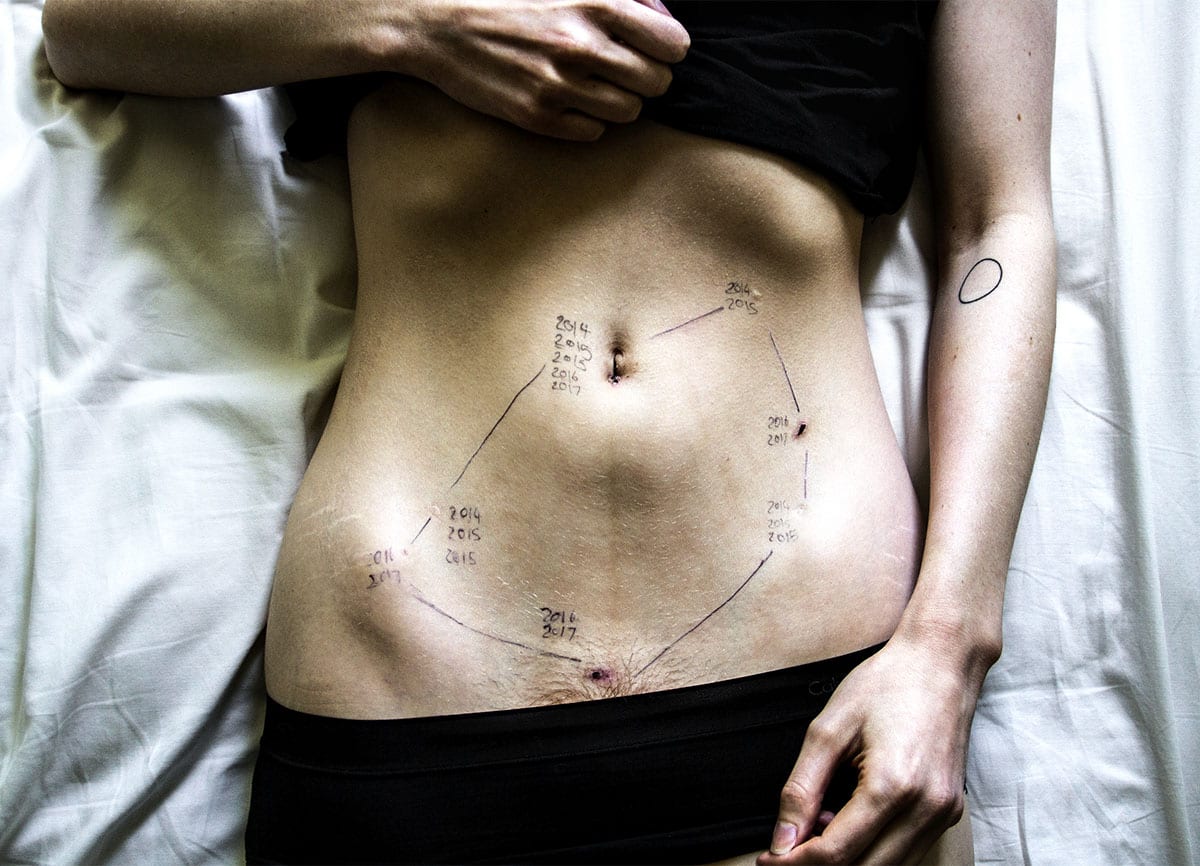PMS vs. PMDD: What’s the difference?
Everything you should know about PMS & PMDD
Sore boobs, an achy vulva, and unexplained moodiness all rudely signal the beginning of our menstrual cycle. For most of us, the days leading up to our period are routine discomforts and inconveniences. It’s a signal to dust off that electric heating pad, pick up our favorite snacks, and restock on period products.
For others, an approaching period can be totally debilitating, bringing with it severe depression, heightened anxiety, and serious mood swings. And then there’s the lucky ones that hardly notices that their period is coming at all.
Premenstrual symptoms exist along a spectrum. The symptoms themselves, and the timeframe in which they are experienced, is generally the same. However, it’s the severity and frequency of the symptoms that makes all the difference. Where most menstruators experience premenstrual syndrome (PMS), approximately 3 – 8% experience its harsher cousin, premenstrual dysphoric disorder (PMDD).((Halbreich, U., Borenstein, J., Pearlstein, T., & Kahn, L. S. (2003). The prevalence, impairment, impact, and burden of premenstrual dysphoric disorder (PMS/PMDD). Psychoneuroendocrinology, 28 Suppl 3, 1–23. https://doi.org/10.1016/s0306-4530(03)00098-2))
In this guide, we’ll explain the range of premenstrual symptoms, including the differences between PMDD vs. PMS. Well also cover where you fall within the spectrum. We’ll also offer a few tips on what you can do to cope with your specific type of period blues.


What is premenstrual syndrome (PMS)?
Learning about what PMS puts your body through is key to fighting the pain it brings.
“PMS” stands for premenstrual syndrome. It can start anytime after you ovulate and usually lasts until you get your period, i.e. until the bleeding begins.((Mayo Clinic. (2018, November 29). Premenstrual dysphoric disorder (PMDD): A severe form of PMS. https://www.mayoclinic.org/diseases-conditions/premenstrual-syndrome/expert-answers/pmdd/faq-20058315))
PMS affects both your emotional and physical wellbeing, and is a frustrating and baffling state to be in. Especially considering all the different ways it can throw your daily activities off-track. Symptoms may include:((American College of Obstetricians and Gynecologists. (2015). Premenstrual syndrome (PMS). https://www.acog.org/patient-resources/faqs/gynecologic-problems/premenstrual-syndrome))
- Breast tenderness
- Acne
- Food cravings
- Cramping
- Bloating and weight gain
- Headache
- Swelling of the hands or feet
- Aches and pains
- Fatigue
- Irritability
- Gastrointestinal symptoms
Some of us even experience “period brain.” Suddenly we can’t concentrate on anything, burst in tears for no reason, dwell on negative thoughts, or become more anxious.((American College of Obstetricians and Gynecologists. (2015). Premenstrual syndrome (PMS). https://www.acog.org/patient-resources/faqs/gynecologic-problems/premenstrual-syndrome))
If any of these symptoms sound familiar, you are not alone. As many as three out of every four menstruators have experienced some form of PMS.((Mayo Clinic. (2020, February 7). Premenstrual syndrome (PMS) – Symptoms and causes. https://www.mayoclinic.org/diseases-conditions/premenstrual-syndrome/symptoms-causes/syc-20376780)) Our bodies go through a lot each cycle!
Keep in mind that PMS is different from dysmenorrhea (an unusually painful period). PMS doesn’t technically happen during your period. PMS happens in the days or weeks leading up to your period, during the luteal phase.
Why PMS happens
Scientists aren’t entirely sure what causes PMS, but most of the evidence points to hormonal changes.
The two main sex hormones for individuals AFABAFAB stands for “assigned female at birth.”, estrogen and progesterone, fluctuate wildly throughout your menstrual cycle. Estrogen peaks in the first half, before and during ovulation, and then progesterone takes over after ovulation.
It’s suspected that these fluctuating estrogen and progesterone levels produce the physical and mood-related symptoms of PMS.((Mayo Clinic. (2020, February 7). Premenstrual syndrome (PMS) – Symptoms and causes. https://www.mayoclinic.org/diseases-conditions/premenstrual-syndrome/symptoms-causes/syc-20376780))
What is premenstrual dysphoric disorder (PMDD)?
PMDD, or premenstrual dysphoric disorder, is a more severe form of PMS.((Mayo Clinic. (2018, November 29). Premenstrual dysphoric disorder (PMDD): A severe form of PMS. https://www.mayoclinic.org/diseases-conditions/premenstrual-syndrome/expert-answers/pmdd/faq-20058315)) The symptoms can look the same as PMS on the surface. However, those with PMDD experience physical and emotional changes to the point that it interferes with their daily life.
Premenstrual dysphoric disorder symptoms
People with PMDD have the unpleasant monthly challenge of fighting off physical and mental discomfort, including depression and suicidal thoughts. Similar to PMS, PMDD symptoms are cyclical. They appear any time post-ovulation, and cool down when (or not long after) you start bleeding again.((Bodden, S. H. (2016, August 1). Premenstrual syndrome and premenstrual dysphoric disorder. AAFP American Academy of Family Physicians. https://www.aafp.org/afp/2016/0801/p236.html)) The cyclical nature of PMDD is what distinguishes it from other disorders that cause similar symptoms, like endometriosis or PCOS.
The ACOGACOG stands for the American College of Obstetricians and Gynecologists (a professional membership organization for obstetrician–gynecologists). offers a few sentences of official guidance around PMDD:((American College of Obstetricians and Gynecologists. (2015). Premenstrual syndrome (PMS). https://www.acog.org/patient-resources/faqs/gynecologic-problems/premenstrual-syndrome))
“If PMS symptoms are severe and cause problems with work or personal relationships, you may have premenstrual dysphoric disorder (PMDD). PMDD is a severe type of PMS that affects a small percentage of women. Drugs called selective serotonin reuptake inhibitors (SSRIs) can help treat PMDD in some women. These drugs are used to treat depression.”
If you’re thinking, “Damn, I knew my period was up to no good,” you’re definitely not alone. As mentioned above, PMDD is suspected to affect somewhere between 3% and 8% of menstruators, but that prevalence may be underreported. Especially given the fact that PMDD was only recently accepted as a health condition by the medical community.1
It wasn’t until 2013 that PMDD was added to the Diagnostic and Statistical Manual of Mental Disorders (the DSM-V). The DSM-V is a mental health dictionary that psychiatrists and psychologists use to diagnose their patients.
Before then, some health experts thought PMDD was a myth. Some health experts were against the recognition of PMDD. They argued that women shouldn’t have to claim they were depressed for the general public to take PMS symptoms seriously. They also thought that symptoms of PMDD were trivial in comparison to more “significant” mental health illnesses.
All this bad press could be why you may have never heard of this disorder before. Thankfully, the premenstrual dragon that is PMDD is now out in the open. And so, we now have a greater body of research to refer to when figuring out how to treat it.
Why PMDD happens
Like PMS, scientists aren’t entirely sure what causes PMDD, or even what makes it so much more severe than PMS. Here are a few of the current hypotheses:
- Hormonal fluctuations during the menstrual cycle — and the way certain bodies react to those fluctuations.2
- People with PMDD don’t necessarily have higher amounts of hormones circulating in their bodies. However, they might be more sensitive to hormonal changes associated with the menstrual cycle.3
- Underlying conditions such as anxiety, depression or other mood disorders don’t cause PMDD. They may, however, play a role in exaggerating premenstrual symptoms due to a drop in serotonin levels. Serotonin is a neurotransmitter that increases feelings of happiness. Additionally, those who have a history of depression may be more likely to have PMDD.((Kumar, P., & Sharma, A. (2014). Gonadotropin-releasing hormone analogs: Understanding advantages and limitations. Journal of Human Reproductive Sciences, 7(3), 170. https://doi.org/10.4103/0974-1208.142476))
What are the risk factors for PMDD?
Those with a family history of Premenstrual Syndrome (PMS) or Premenstrual Dysphoric Disorder (PMDD) may be at an increased risk. Those with a history of depression, postpartum depression, or other mood disorders may be more likely to develop PMDD.
Molimina: A milder form of PMS
Here’s a new word for your reproductive health glossary: Molimina. It’s an older term used to describe “normal, non-bothersome changes in experience that women may perceive before menstruation (premenstrually). Molimina is reported to occur only in ovulatory cycles. It may involve physical changes such as fluid retention, breast tenderness, or negative moods.”4
Molimina is a little bit like PMS, but milder and probably more widely experienced. Instead of feeling the raging symptoms of PMS and PMDD, molimina symptoms welcome the menstrual flow with gentle little nudges.
Beyond fluid retention, breast tenderness, and mood changes, molimina can also include cramps, acne, and increased appetite. On the spectrum, this is the least severe way that people experience the arrival of their periods.((Mayo Clinic. (2020, February 7). Premenstrual syndrome (PMS) – Symptoms and causes. https://www.mayoclinic.org/diseases-conditions/premenstrual-syndrome/symptoms-causes/syc-20376780))
Why do some people react more strongly to hormonal fluctuations than others?
That is certainly a great question. OBGYN Dr. Heather Bartos says, “We honestly don’t know why. For some, it can certainly be stress, diet, exercise (or lack thereof).”
We also spoke with reproductive health & advocacy fellow Dr. Aisha Wagner. She explained that there is some evidence that those who experience PMS or PMDD usually have lower levels of circulating serotonin.
Dr. Bartos adds that progesterone, the hormone that rules the second half of the cycle, can have a depressing effect. The combination of higher progesterone and lower serotonin levels can really throw some of us off balance.
How to tell if you’re experiencing molimina, PMS, or PMDD
Here are some helpful guides to see where you fall along the spectrum of premenstrual woes:
- PMS diagnostic criteria from the American Academy of Family Physicians (AAFP)
- PMDD diagnostic criteria from the American Psychiatric Association (APA). A person has to have at least 5 out of the 11 symptoms to be diagnosed with PMDD.
No matter where you fall on the spectrum, it’s important to know that your pain is real. For too many years, female pain has been silenced by the (sometimes archaic) infrastructure of Western medicine. If you’re experiencing debilitating symptoms leading up to your period, talk to your healthcare provider right away.
It might be helpful to download a cycle tracking app where you can record PMS symptoms. You can track the severity of your symptoms, and share them with your doctor during your next appointment.
Helpful tips for dealing with PMS & PMDD
We gathered some tips from health professionals and people who have PMDD and have managed to cope with its symptoms.
Always talk to your healthcare provider if your PMS or PMDD symptoms interfere with your day-to-day life. Beyond that, give some of the following tips a try:
Track your cycles and symptoms. Having a record of your symptoms makes PMDD much easier to diagnose and treat. You’ll want to track the following data:
- Your emotional and physical symptoms on the days preceding your period
- When these symptoms happen, how severe they are, and how long they last
- When you actually get your period
Ask your doctor about PMS and premenstrual dysphoric disorder treatment options, including prescription medication. Like we said earlier, lower serotonin levels can aggravate PMS/PMDD symptoms. This is why SSRIs (antidepressants) might provide the support you need for your mental health.
You may only need to take antidepressants between ovulation and the start of your period. Talk to your doctor to better understand the pros and cons.((Mayo Clinic. (2018, November 29). Premenstrual dysphoric disorder (PMDD): A severe form of PMS. https://www.mayoclinic.org/diseases-conditions/premenstrual-syndrome/expert-answers/pmdd/faq-20058315))
For some, hormonal birth control is also effective in regulating PMS and PMDD symptoms. Depending on the type of contraceptive you choose, you may experience shorter or lighter periods — or no periods at all. Just remember that birth control comes with its own set of side effects. Your body is unique, so it may not react to a certain type of contraceptive as your friend or family did.
Several studies suggest the best birth control pills for controlling PMS or PMDD symptoms are those that contain the hormone drospirenone.((De Berardis D, Serroni N, Salerno RM, Ferro FM. Treatment of premenstrual dysphoric disorder (PMDD) with a novel formulation of drospirenone and ethinyl estradiol. Ther Clin Risk Manag. 2007 Aug;3(4):585-90. PMID: 18472980; PMCID: PMC2374943.))
Hormonal birth control and SSRIs are the two most popular options when it comes to treating PMS or PMDD with medication. However, there are other medications out there. Do your research so that you can have an informed discussion with your provider.
Reframe the battle. It’s important to recognize that the pain you feel is valid. PMDD Warrior Brett Buchert shares that, for years before her diagnosis, she thought the symptoms were her fault. She told us she used to think her pain “only felt so intense because I was weak.”
“I finally realized that this bag of PMDD hell was just dropped on me, not my fault, and I am wickedly strong to still be breathing under its weight,” she continues. Something as simple as an official diagnosis from your provider can help you reframe your experience. Remember that it’s only temporary – and there are legitimate pmdd treatment options.
Try eating a healthier diet. Nutrition is so important to your hormonal health. Recently, researchers have found that your gut microbiome acts like “a conductor of an orchestra, leading your symphony of hormones.”
Your gut microbiome is the chemical environment in your digestive system, influenced by your diet. So if you’re experiencing horrible PMS symptoms, it could be due to a hormonal imbalance partially caused by your diet.
There are ways to rebalance your hormone levels and restore the health of your gut microbiome. Programs like Alisa Vitti’s Floliving and Nicole Jardim’s Fix Your Period, can help curb PMDD and PMS symptoms. Need some quick meals to boost your mood and kick cramps to the curb? Check out these five recipes for PMS and period pain.
Consider supplements and herbs. There is some solid evidence that certain nutritional supplements and herbal remedies might alleviate PMS/PMDD symptoms. For instance, ingesting 1,000 milligrams of calcium daily could decrease PMS/PMDD symptoms for some people. Other supplements like Vitamin B6, magnesium, and L-tryptophan have also shown promise.((Harvard Health Publishing. (2020, June 17). Will Prozac help my premenstrual depression? Harvard Health. https://www.health.harvard.edu/womens-sexual-health/ask-the-doctor-will-prozac-help-my-premenstrual-depression))
Dr. Erica Matluck is a naturopathic doctor and women’s health expert. She shares that Vitex is her favorite herb to treat PMS and PMDD. It helps balance progesterone levels, so it can mitigate a variety of symptoms. However, always check in with your healthcare provider before starting any herbal, vitamin-, or mineral-based supplements.
Try seed-cycling. It sounds a little crazy, but some people swear by it. “Seed-cycling” has been promoted as a way to balance your hormones. It recommends eating different types of seeds at different points of your menstrual cycle.
There is little scientific evidence to back it up. However, some holistic providers, like naturopath Dr. Jolene Brighten, say it’s the real deal.
It starts with four seeds: flax, pumpkin, sunflower, and sesame seeds. Eating these seeds can enhance or inhibit the production of estrogen and progesterone in the body and relieve symptoms. Learn more about seed cycling from Dr. Katherine Takayasu, MD on the Stamford Health blog.
Exercise. It might sound like the last thing you’d want to try when you’re PMSing. Nevertheless, exercise can really boost mood and energy levels.((Harvard Health Publishing. (2019, September 24). Treating premenstrual dysphoric disorder. Harvard Health. https://www.health.harvard.edu/womens-health/treating-premenstrual-dysphoric-disorder))
One study found that twelve weeks of yoga improved menstrual pain and physical function. The study also found that it significantly decreased abdominal swelling, cramps and breast tenderness. An enhanced general health perception, energy levels, and mental health were also reported.((Tsai, S. (2016). Effect of yoga exercise on premenstrual symptoms among female employees in Taiwan. International Journal of Environmental Research and Public Health, 13(7), 721. https://doi.org/10.3390/ijerph13070721)) It’s likely that these results carry over to dysmenorrhea and PMS/PMDD.
Here are a few workouts to try when you’re PMSing (or even during your period).
Find a supportive community. Severe PMS or PMDD can feel pretty isolating. Thankfully, online networks allow us to connect with people who understand how we’re feeling while we’re waiting to bleed. Here are some places to go for support:
- Check out the International Association for Premenstrual Disorders (IAPMD). This is a nonprofit that provides different kinds of free support (peer and group). It also provides resources, and community-building services in various languages to help people with premenstrual disorders.
- Listen to these podcasts: Power Over PMDD, The PMDD Diaries , It’s Not You, It’s Me – A PMDD Podcast
- Join PMDD support groups on Facebook and Instagram. PMDD/Severe PMS Support and Information Group, PMDD and PME Support Group, Vicious Cycle PMDD, Me vs. PMDD
This article is informational only and is not offered as medical advice, nor does it substitute for a consultation with your physician. If you have any gynecological/medical concerns or conditions, please consult your physician.
© 2023 The Flex Company. All Rights Reserved.
- Halbreich, U., Borenstein, J., Pearlstein, T., & Kahn, L. S. (2003). The prevalence, impairment, impact, and burden of premenstrual dysphoric disorder (PMS/PMDD). Psychoneuroendocrinology, 28 Suppl 3, 1–23. https://doi.org/10.1016/s0306-4530(03)00098-2 [↩]
- Bodden, S. H. (2016, August 1). Premenstrual syndrome and premenstrual dysphoric disorder. AAFP American Academy of Family Physicians. https://www.aafp.org/afp/2016/0801/p236.html [↩]
- Potter, J., Bouyer, J., Trussell, J., & Moreau, C. (2008). Premenstrual syndrome prevalence and fluctuation over time: Results from a French population–based survey. Contraception, 78(2), 194. https://doi.org/10.1016/j.contraception.2008.04.109 [↩]
- Prior, J. C., Konishi, C., Hitchcock, C. L., Kingwell, E., Janssen, P., Cheung, A. P., Fairbrother, N., & Goshtasebi, A. (2018). Does Molimina Indicate Ovulation? Prospective Data in a Hormonally Documented Single-Cycle in Spontaneously Menstruating Women. International Journal of Environmental Research and Public Health, 15(5), 1016. https://doi.org/10.3390/ijerph15051016 [↩]









